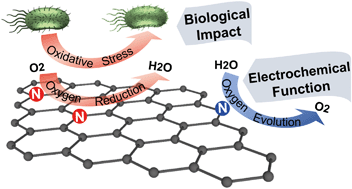当前位置:
X-MOL 学术
›
Environ. Sci.: Nano
›
论文详情
Our official English website, www.x-mol.net, welcomes your feedback! (Note: you will need to create a separate account there.)
Leveraging electrochemistry to uncover the role of nitrogen in the biological reactivity of nitrogen-doped graphene†
Environmental Science: Nano ( IF 7.3 ) Pub Date : 2019-09-09 , DOI: 10.1039/c9en00802k Yan Wang 1, 2, 3, 4 , Nathalia Aquino de Carvalho 1, 2, 3, 4 , Susheng Tan 2, 3, 4, 5, 6 , Leanne M. Gilbertson 1, 2, 3, 4, 7
Environmental Science: Nano ( IF 7.3 ) Pub Date : 2019-09-09 , DOI: 10.1039/c9en00802k Yan Wang 1, 2, 3, 4 , Nathalia Aquino de Carvalho 1, 2, 3, 4 , Susheng Tan 2, 3, 4, 5, 6 , Leanne M. Gilbertson 1, 2, 3, 4, 7
Affiliation

|
While nitrogen doping greatly broadens graphene applications, relatively little is known about the influence of this heteroatom on the biological activity of graphene. A set of systematically modified nitrogen-doped graphene (NG) materials was synthesized using the hydrothermal method in which the degree of N-doping and N-bonding type is manipulated using two nitrogen precursors (urea and uric acid) and different thermal annealing temperatures. The bioactivity of the NG samples was evaluated using the oxidation of the intracellular antioxidant glutathione (GSH) and bacterial viability (of Escherichia coli K12), and oxidative stress was identified as the predominant antibacterial mechanism. Two key energy-relevant electrochemical reactions, oxygen reduction reaction (ORR) and oxygen evolution reaction (OER), were used to characterize the influence of different N-types on the electronic properties of the NG materials. Electron-donating graphitic-N and electron-withdrawing pyridinic-N were identified as effective promoters for ORR and OER, respectively. The similar mechanisms between the GSH oxidation (indicative of oxidative stress) and ORR mechanisms reveal the role of graphitic-N as the active site in oxidative stress related bioactivity, independent of other consequential properties (e.g., defect density, surface area). This work advances a growing rational design paradigm for graphene family materials using chemical composition and further provides valuable insight into the performance-hazard tradeoffs of NG applications in related fields.
中文翻译:

利用电化学发现氮在掺氮石墨烯的生物反应性中的作用†
尽管氮掺杂极大地拓宽了石墨烯的应用范围,但对于这种杂原子对石墨烯生物活性的影响知之甚少。使用水热法合成了一组系统改性的氮掺杂石墨烯(NG)材料,其中使用两种氮前体(尿素和尿酸)和不同的热退火温度来控制N掺杂和N键类型的程度。使用细胞内抗氧化剂谷胱甘肽(GSH)的氧化和细菌的生存力(大肠杆菌)评估NG样品的生物活性。K12),氧化应激被认为是主要的抗菌机制。两种与能量相关的关键电化学反应,氧还原反应(ORR)和氧释放反应(OER),用于表征不同N型对NG材料电子性能的影响。供电子的石墨N和吸电子的吡啶N分别被认为是ORR和OER的有效启动子。GSH氧化(指示氧化应激)和ORR机制之间的相似机制揭示了石墨N作为氧化应激相关生物活性中的活性位点的作用,而与其他后果无关(例如,缺陷密度,表面积)。这项工作为使用化学成分的石墨烯族材料提供了一个不断发展的合理设计范式,并为相关领域中NG应用的性能-危害折衷提供了宝贵的见识。
更新日期:2020-01-02
中文翻译:

利用电化学发现氮在掺氮石墨烯的生物反应性中的作用†
尽管氮掺杂极大地拓宽了石墨烯的应用范围,但对于这种杂原子对石墨烯生物活性的影响知之甚少。使用水热法合成了一组系统改性的氮掺杂石墨烯(NG)材料,其中使用两种氮前体(尿素和尿酸)和不同的热退火温度来控制N掺杂和N键类型的程度。使用细胞内抗氧化剂谷胱甘肽(GSH)的氧化和细菌的生存力(大肠杆菌)评估NG样品的生物活性。K12),氧化应激被认为是主要的抗菌机制。两种与能量相关的关键电化学反应,氧还原反应(ORR)和氧释放反应(OER),用于表征不同N型对NG材料电子性能的影响。供电子的石墨N和吸电子的吡啶N分别被认为是ORR和OER的有效启动子。GSH氧化(指示氧化应激)和ORR机制之间的相似机制揭示了石墨N作为氧化应激相关生物活性中的活性位点的作用,而与其他后果无关(例如,缺陷密度,表面积)。这项工作为使用化学成分的石墨烯族材料提供了一个不断发展的合理设计范式,并为相关领域中NG应用的性能-危害折衷提供了宝贵的见识。


























 京公网安备 11010802027423号
京公网安备 11010802027423号